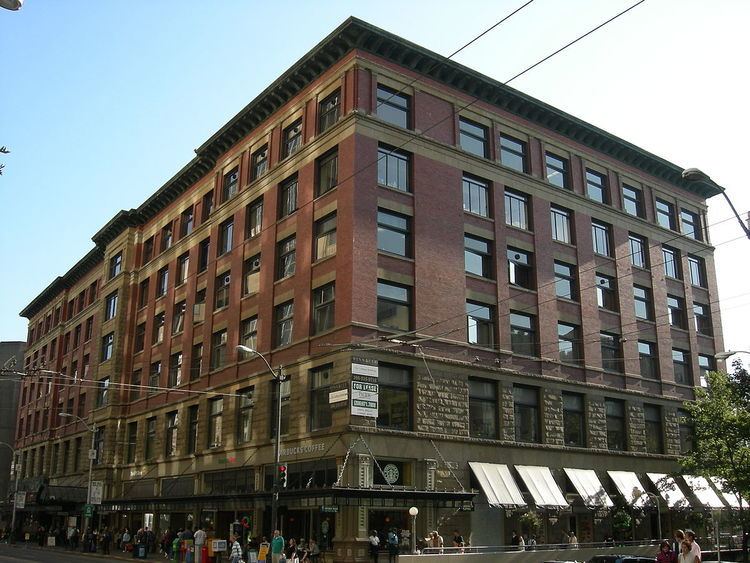Built 1889, 1904-6 Added to NRHP 1972-03-16 | NRHP Reference # 72001272 | |
 | ||
Architect Stephen Meany, August Tidemand Architectural style Romanesque, Chicago School | ||
The Colman Building is a historic office building located in Seattle, Washington. It occupies a half of a block in downtown Seattle in proximity to Pioneer Square, bound by First Avenue, Marion and Columbia Streets. It is listed on the National Register of Historic Places as well as being a City of Seattle landmark. The building was built in several stages with a change of design between 1889 and 1906. It was commissioned by Scottish immigrant and master machinist James Colman who arrived in Seattle in 1872. Architect Stephen Meany designed the original plans while the reconstruction that is visible today was designed by August Tidemand inspired by the Chicago School with less ornamentation and large pivoting windows. The cast iron elements from the original building remain on the first floor, while the second floor was rebuilt of rusticated stone. Four floors of red brick trimmed with marble were built on top of this. The building is crowned with a copper cornice.
Contents
James Colman and the first Colman Building
James Colman owned the entire block of First Avenue between Columbia and Marion Streets. According to legend, he came to acquire the property when he towed the wrecked ship Windward to shore there intending to salvage it. When the Colman building was later built on the site, the ship's hull was surrounded by land and buried under the foundation where it still lies in the sub-basement.
In 1888, James Colman commissioned architect Stephen Meany to design a large office building that would occupy his property. His design was an ornate five story Romanesque edifice faced in plaster and featuring a large central tower. While the cornerstone was laid in early 1889, Colman put off construction in order to keep collecting rents on buildings still on the property as long as possible. Construction of the building was made easier when the Great Seattle Fire of 1889 wiped out all of the buildings on the block. Construction commenced as soon as the debris was cleared.
During the rebuilding of Seattle in the aftermath of the fire, a huge surplus of office space was being created with all of the multi-story structures being built simultaneously. Noticing this, Colman halted construction of the building, which had only reached its second floor. It remained in this unfinished form for the next fifteen years. In the meantime, the building housed many important businesses and social clubs like the Elks and the Seattle Bureau of Information, whose sole purpose was to keep the newspapers in on the East coast supplied with good news about the city. The Customs House operated within the Colman Building as well as the Circuit Court. Also during this time, Colman erected a stone warehouse occupying the other half of the block, known as The Colman Block Annex, which has since been demolished for a parking lot.
Reconstruction
Construction of the Colman Building was finally resumed in February 1904 and by this time, architectural tastes had changed, and Colman hired Norwegian architect August Tidemand, who had designed the Colman Block Annex, to completely rebuild the building in a Chicago School style while still echoing the building's intended 1889 layout. Tenants were moved to the nearby Burke Building until construction finished. Perks of the new building would include 300 offices, fireproof construction and stair fire escapes. Another improvement over the old building would be the addition of three elevators with 24-hour operators. As construction began in early 1904 The Seattle Times noted the improved service over that of the Colman Building at the time:
Reconstruction of the building involved removing most of the brick facade to be replaced with stone. Several cast iron elements including the entrance arch and storefront columns were retained and integrated into the new facade. When completed in 1906, the new building rose six stories high and cost $150,000.
The Colman Building housed several businesses that catered to miners during the Alaska Gold Rush as well as housing several administrative offices for the Alaska-Yukon-Pacific Exposition in 1908-9.
The lobby of the building was completely rebuilt in 1930 with designs by Seattle architect Arthur Loveless.
Recent history
On March 16, 1972, the Colman Building was listed on the National Register of Historic Places. In October 1978, the building was purchased by CHG-City Center Investors, who began a ten-year, three phase process of restoring the building to its original grandeur. On March 19, 1990, the Colman Building became a City of Seattle Landmark (Ordinance #114993) on nomination by CHG International of Federal Way, Washington, with James Mason as their agent.
The Colman Building was brought back to local ownership in 1997 when Triad Development purchased the building for $7.1 million from Plaza Realty Holdings Inc. of Long Beach, California. They had in turn purchased the building out of foreclosure in 1996. Triad spent over two million dollars in renovations including new air conditioning and better interior lighting as well improving street level businesses.
